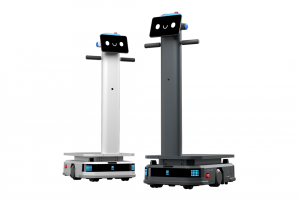Your Address Book Goes Multi-Platform
Your desk may be filled with all sorts of disorganized paper piles. Your receipts may not be making it into an organized shoebox. Who knows how often you do laundry. You sure aren’t balancing your checkbook.
However, no matter how disorganized you are, you keep very sacred your electronic address book. Once upon a time, 20 years ago, you may have started it in a simple word processor or spreadsheet. Then it turned into the mighty Palm organizer, ca 1997. Then a year or two later you finally switched to Microsoft Outlook. By 2001 you had started synchronizing Outlook with your BlackBerry.![]()
Then in the last couple of years, you also got an iPhone, an iPad and an Android smartphone or tablet. Your online services now include Google and its Gmail and address book, as well as Apple’s MobileMe, which turned into iCloud a couple of months ago. Most recently, you also added a Microsoft 7.5 “Mango” smartphone to your arsenal.
So now you have any combination of several possible multiplatform address book scenarios. The most powerful program at the heart of the nexus remains Microsoft Outlook. In Outlook, you can sort your entries any way you want, with columns determining zip codes, titles, phone numbers, street addresses, and more. There is also no limit on how many addresses you can store there. As far as I can tell, you can hit 100,000 address book entries if you get that far.
Proliferation
Speaking of getting there, is 100,000 address book records that unrealistic anymore? Let’s do a little math experiment. On an average weekday, you add four people to your address book: A new customer or two, a friend you met, a supplier, a colleague, someone from the soccer team, a new instructor at school — four per day is not an unreasonable assumption.
Let’s further assume you don’t do this 365 days a year, but only 250. Then you are adding 4 x 250 per year, or 1,000. You start getting organized when you get into college, age 18, and you end at the average life expectancy, 78. That’s 60 years. 60 years x 1,000 address book records added = 60,000 in your database.
Many people of course add more than four people a day, and perhaps more than 250 days per year. Others start before the age of 18, and they live much beyond the average life expectancy. As a result, that 60,000 per person normalized estimate in the previous paragraph will end up being 100,000 in a decent number of cases.
You can immediately see that you will be running into some limitations here. At some point, the maximum number of contacts in Microsoft/Hotmail might have been 5,000 or even less. Google/Gmail and Apple/iCoud both have a 25,000 limit. Plaxo, which specializes in synchronizing the address book with just about anything, is limited to only 10,000.
In other words: To varying degrees, most systems fall short of an emerging reality where reasonably organized people over a career’s length can perhaps be assumed to average 60,000 contacts. Obviously, a large portion of regular people have yet to approach some of these limits imposed by various cloud databases today, but I imagine this problem will grow rapidly in the coming years.
Then you also have another problem: field support. You would think that all of these various mega-entities — Apple, Microsoft, Google, BlackBerry and others — would have agreed on using the same fields for phone numbers, email addresses, physical addresses, and so forth. And labeling them the same way.
But you would be wrong in this natural assumption.
Some of these entities seem to fully agree on the fields that they support. Microsoft and BlackBerry, for example, support the same fields. These include three email addresses, a few defined phone numbers such as “Work,” Work 2,” “Home,” Home 2″ and so forth.
Other entities do it differently. Have you ever tried synchronizing an Apple or Google database with Outlook and/or BlackBerry? Apple and Google support a different number and labeling of phone, email and physical address fields than Microsoft and BlackBerry do.
Take the categories field in Outlook, for example. You may have spent the last 10 to 20 years carefully organizing your address book records by assigning one or more category labels to each of these records. That will translate perfectly if you synchronize them with your BlackBerry. Now try synchronizing your Outlook address book database with either Google, Apple or both. Good luck. And that’s even before considering the 25,000 contacts limit in your Apple and Google systems.
About That Good Old USB Sync…
At least if you use that USB cable to plug in your BlackBerry to your PC for address book synchronization, you will be able to go over 25,000 contact records. But if you switch out that BlackBerry for a Windows Phone 7.5 device, you can no longer synchronize your address book over USB cable. You have to do it wirelessly. How? Until now, you had your database in your laptop, while perhaps using Gmail for your email.
Yes, Virginia, you can’t synchronize your Microsoft Windows Phone 7 with your Microsoft Outlook for Windows 7 over USB. You have to obtain Microsoft Exchange server support. This does not mean actually buying a Microsoft Exchange server and maintaining it, but signing up for outsourcing one unit of MS Exchange service. Try explaining this to a regular non-techie person! How many average Americans would know how to proceed at this juncture?
Furthermore, what about those people who don’t want to save a version of their address book in the cloud, but prefer to synchronize locally, with a PC as the hub surrounded by spokes of smartphones and tablets? BlackBerry and Apple support this, and we know Google doesn’t. But why shouldn’t Microsoft allow its own PCs to talk to its own smartphones over a USB cable? Apparently, Microsoft has now forced its users’ address books to the cloud, whereas if a person with a Microsoft PC or an Apple PC could keep this information away from the cloud by synchronizing via USB to a BlackBerry or iOS device such as the iPhone or iPad.
The Web/desktop app experience afforded by Microsoft, Apple and Google have one common point of failure: Views of the contact record. One would think that by clicking on a contact record, one would immediately see all the fields that one could populate. For example, if you didn’t pull down menu after menu, would you know how many email addresses you could fit into an address book record in the Google, Apple and Microsoft address books?
In other words, the interfaces should show all the empty fields that you could populate. I can see why on a smartphone, it may make sense to leave some or many of the fields as drop-down options as a result of the small screen real estate. However, on even the smallest of laptops, let alone a desktop monitor, there are enough inches and pixels to expose absolutely every field that’s not yet populated.
Solutions for World Peace
I’m a cranky complainer, but I’m also a cranky complainer with solutions ready for the world to adopt. Apple, Google, Microsoft, BlackBerry and perhaps also other entities such as Plaxo need to agree on a common set of field definitions, so that the exact type and number of phone numbers (and the other types of fields) in a contact record corresponds precisely to the other systems. The labeling of these fields need to match across devices precisely.
In addition, it would be welcome if these ecosystem giants agreed on a more realistic limit for the number of contacts, and this limit should be lifted to 100,000 as an initial step. This, combined with supporting the same fields with the same labels, and exposing all these fields visually without the need for pull-down menus, would make a pleasant multi-device synchronization environment possible. As it stands right now, the solutions on the table today have some serious limitations that need to be lifted.
Maybe it’s the kind of pipe dream we otherwise wished from The League of Nations, The United Nations, the debt commission, and general peace and prosperity on Earth, but I would like to see Google, Microsoft and Apple sit down to agree on these common standards for address book standards and managements. Perhaps also other entities such as BlackBerry and Plaxo would be vital participants in this effort.
If Microsoft, Google, Apple and BlackBerry can do this, they would be an example for our government in their quest to end the grid-lock to solve our nation’s, and the world’s, problems. Let’s get a summit together on this, shall we?
[Cross-posted at The Street]
A message from John Furrier, co-founder of SiliconANGLE:
Your vote of support is important to us and it helps us keep the content FREE.
One click below supports our mission to provide free, deep, and relevant content.
Join our community on YouTube
Join the community that includes more than 15,000 #CubeAlumni experts, including Amazon.com CEO Andy Jassy, Dell Technologies founder and CEO Michael Dell, Intel CEO Pat Gelsinger, and many more luminaries and experts.
THANK YOU













